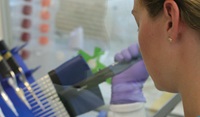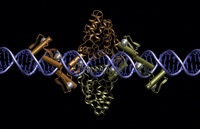New tools for genetic modification will replace traditional and laborious genetic engineering processes with fast and precision genetic surgery, reports Cath O’Driscoll
Rats are more like humans than we might realise. It is estimated that 90% of the 25,000-30,000 rat genes are analogous to those in humans. We are physiologically more similar to rats than mice for many traits and their larger size makes them a better model for drug evaluation studies.
Gene surgery
However, the rat’s usefulness as a model of human disease has been hampered because ‘until now, rat geneticists lacked a viable technique for “knocking out” or mutating specific genes to understand their function,’ says Howard Jacob, director of the human and molecular genetics centre at the Medical College of Wisconsin, US. Creating knockout rats is much more tricky than creating knockout mice.
In July, Jacob and collaborators at US biotech firms Sangamo Biosciences and OMT published a paper in Science that could change all of that. The researchers reported creating the first knockout rats made by using Sangamo’s proprietary zinc finger technology (DOI: 10.1126/science.1172247) – which allowed them to inactivate the rat gene encoding rat immunoglobulin M (IgM), a key gene in rat antibody production.
But zinc finger technology is tipped for even wider application. Last month, Sangamo announced that it has licensed the technology for the production of transgenic animals for research and commercial use to Sigma-Aldrich and the first rat models are now being generated at Sigma’s Advanced Genetic Engineering Lab in St Louis, US. ‘ZFN-based gene editing is rapidly emerging as a critical tool in modern biotechnology,’ says David Smoller, president of Sigma-Aldrich’s Research Biotech Unit. ‘… we are now able to generate transgenic animals in species in which it was previously impossible to efficiently and specifically carry out genome modification.’
The market for genetically modified organisms (GMOs) is currently worth an estimated $10bn, with some experts predicting that this figure will climb to $50bn by 2025, according to equity research firm Natixis Securities. However, traditional genetic engineering is a hit and miss affair. New genes carrying the desired function are transferred into the organism to be modified via transport vehicles called vectors, often with very low success rates. And even once the vector has entered cells, the new genes are taken up and integrated into the existing genetic material quite randomly, requiring laborious screening and selection processes.
New engineering tools, including zinc finger technology, promise to greatly improve the precision with which genetic modifications are carried out. ‘Where previously we were looking at [targeting a particular genetic site with] one in a million efficiency, now we can do it in 20, 30 or even 40% of alleles in cells, so it’s multiple times more efficient,’ says Sangamo ceo Edward Lanphier. ‘With plants, we can save two to three years’ time to create GM plants, with engineered cell lines for manufacturing antibodies and so on we can save six months. And we can change glycosylation, enzyme active sites etc – things we can’t do any other way.’
Sangamo’s technology is based on engineered versions of naturally occurring Zinc Finger Proteins (ZFPs), also known as transcription factors (TF) because they regulate the amounts of proteins being made. Zinc Finger Nucleases (ZFNs) are made by linking these ZFPs to so-called nuclease domains that also cut and repair DNA. While Sangamo’s ZFNs are proprietary, others are also being developed separately by the Zinc Finger Consortium, a group of academics and other research organisations that aims to make the resulting proteins publicly available as a research tool.
French biotech firm Cellectis is one of Sangamo’s few commercial competitors. Its technology is focused on other naturally occurring enzymes called meganucleases: molecular scissors that home in and snip DNA at the exact site needed. Meganucleases can’t regulate genes by themselves, but they may be used with other oligonucleotide strands that are introduced where the DNA is cut.
‘These new processes are more like “genetic surgery” than genetic engineering,’ says Cellectis’ ceo Andre Choulika; instead of randomly introducing new genes, they direct them precisely to the exact site where they are needed and so avoid any potential errors: ‘They will dramatically improve the speed, efficiency and safety with which GMOs are made.’
Yet other technologies, meanwhile, involve transposons – genes that can move within DNA. Engineered versions of their encoded transposase enzymes have already been found to transfer newly introduced genes far more efficiently than the native enzymes (C&I 2009, 10, 9), although these so-called Sleeping Beauty, Frog Prince and piggyBac transposon technologies have yet to progress beyond lab model systems.
Therapeutic applications
Genetic therapies based on these new tools are already well-advanced. Sangamo’s ZFP TF for diabetic neuropathy – the cause of thousands of limb amputations annually – is now in Phase 2 trials and works by ramping up the expression of the VEGF A gene to protect and regenerate nerves damaged by high blood glucose. And Sangamo is also carrying out Phase 1 trials at the University of Pennsylvania, US, with a ZFN to disrupt CCR5, a co-receptor for HIV.
‘Most gene therapy for genetic defects has been gene supplementation until now, for example, you ignore the faulty gene and just add in a functional additional version,’ says Andrew Lever, a professor in the department of medicine at the University of Cambridge, UK. ‘In theory these new technologies can repair and even replace the defective gene.’

Better targeted gene therapies for X-SCID are still at the very early stages but could potentially slash the numbers of leukaemia cases and improve safety, according to Choulika. In July, Cellectis published a paper in Nucleic Acids Research (doi:10.1093/nar/gkp548) demonstrating that its meganuclease technology can target Rag1, one of the genes that causes SCID.
But while these new gene surgery tools will bring benefits, Lever cautions that they will not solve all the problems. ‘With every form of genetic therapy the biggest hurdle is delivery, either getting it into a person or then getting it into the specific cells,’ he says.
As with the existing therapies, they will continue to depend on vectors or other mechanisms of delivering the genetic material to cells.
Agbiotech applications
Agricultural applications for these new technologies are likewise hotly pursued. In April, Sangamo and Dow AgroSciences reported using ZFNs to introduce a herbicide tolerance gene into a pre-determined site in the maize genome.
The paper, published in Nature (DOI: 10.1038/459337a), showed how in a rapid, single step, researchers had disabled a gene involved in producing phytate – a natural but undesirable compound found in feed crops – and introduced a new trait for herbicide tolerance.

New crop varieties with increasingly complex and stacked genetic modifications – combining multiple traits such as for drought tolerance and herbicide resistance, for example – are becoming increasingly important as farmers seek to grow more crops using less land. Making these new crops with earlier technologies would have previously been extremely difficult if not impossible, says Cellectis’ Choulika, noting that new genetic surgery tools should rapidly accelerate the development of new enhanced crops.
Cellectis has five agbiotech agreements, with DuPont, BASF, Bayer, Limagrain and Monsanto. The first three of these are R&D partnerships, including plans with Bayer to build new meganucleases for specific commercial traits, while the last two are non-exclusive licensing deals that allow the firms access to Cellectis’ IP and its custom production platform. Choulika says he expects the first GM crops created with the technology to be available by 2012.
Other applications
Elsewhere, yet other applications for these new gene surgery tools promise to speed the development not only of whole organisms but also of individual cell lines needed for the manufacture of proteins such as antibodies. In recent months, for example, Cellectis has introduced cell engineering kits that allow life sciences researchers to create their own cell lines in the laboratory more easily and cheaply than by outsourcing the work to external service providers. Kits developed by Sigma are in development and should be available in the next few months.
Knockout rats may be among the first examples of the application of these new gene surgery tools, but the opportunities for exploiting them are seemingly endless. Crucially, both ZFPs and meganucleases are found in many different living cell types. By changing their constituent amino acids, researchers claim to be able to develop proteins that will target any gene in any cell.





